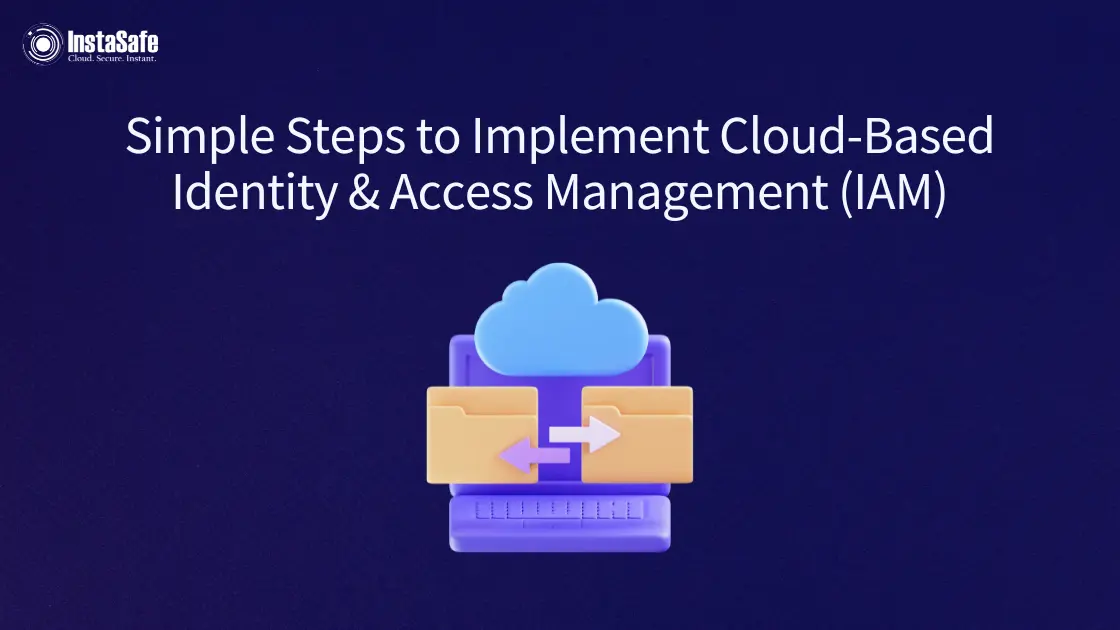Simple Steps to Implement Cloud-Based Identity & Access Management (IAM)

Managing who can access your organisation's cloud resources is critical for security. Cloud-based Identity and Access Management (IAM) provides a streamlined way to control user access across all your cloud services. Unlike traditional systems, cloud-based IAM solutions offer flexibility, scalability and centralised control.
This guide outlines simple steps to implement IAM in cloud computing environments. Whether you are new to cloud security or upgrading existing systems, these straightforward approaches will help you create a robust identity management framework that protects your valuable cloud resources.
Steps to Implement Cloud-Based IAM
1. Understanding Cloud-Based IAM
Cloud-based IAM serves as the security backbone for your cloud computing environment. At its core, IAM in cloud computing is all about controlling who (users, services or applications) can access what (data, applications or systems) within your cloud infrastructure.
Think of cloud-based IAM as a smart security guard for your digital resources. This guard checks everyone's ID (authentication), decides what rooms they can enter (authorisation) and keeps detailed records of who went where (auditing).
Key components of a cloud-based IAM solution include:
- User Management: Creating, modifying and removing user accounts in one central place
- Authentication: Verifying user identities through passwords, multi-factor authentication or biometrics
- Authorisation: Determining what resources users can access based on their roles or attributes
- Single Sign-On (SSO): letting people log in to various apps with the same passwords
- Compliance Tracking: Monitoring and reporting on access activities to meet regulatory requirements
The main benefit of cloud-based IAM is centralisation. You manage all identities and permissions from a single dashboard instead of configuring access separately for each cloud service. This reduces security gaps and simplifies administration, especially in multi-cloud environments.
2. Assessing Your Current IAM Infrastructure
Before implementing a new cloud-based IAM strategy, you need to understand what you already have in place. This evaluation identifies weaknesses and opportunities.
Start by creating a complete inventory of:
- Users and Groups: List all individuals, teams and departments that need access to cloud resources
- Applications and Services: Document all cloud services, platforms and applications currently in use
- Access Requirements: Map out who needs access to what resources and why
- Existing Security Measures: Note down current authentication methods, password policies and access controls
- Compliance Requirements: Identify industry regulations or standards you must follow
Look for common problems in your current setup, such as:
- Scattered user management across multiple platforms
- Inconsistent access control policies
- Manual provisioning processes that slow down work
- Limited visibility into who has access to sensitive resources
- Weak authentication methods
This assessment clarifies your starting position and helps you define achievable cloud-based IAM objectives. Document your findings thoroughly, as they will guide your strategy development in the next step.
3. Implementing a Cloud-Based IAM Strategy
With a clear understanding of your needs, you can now build and deploy your cloud-based IAM solution. Follow these practical steps:
Select the right IAM solution
Choose a cloud-based IAM provider that matches your requirements. Consider factors like compatibility with your existing cloud services, ease of use, security features and cost. Popular options include AWS IAM, Azure Active Directory or Google Cloud IAM.
Start with Core Identity Management
- Set up your user directory with clear naming conventions.
- Define user groups based on departments or job functions.
- Establish strong password policies and multi-factor authentication.
- Configure single sign-on (SSO) for your most-used applications.
Apply the Principle of Least Privilege
- Grant users only the permissions they need.
- Create role-based access controls (RBAC) for different job functions.
- Use time-limited access for contractors or temporary projects,
Implement in Phases
- Start with non-critical applications to test your setup.
- Train a small group of users before full deployment.
- Collect feedback and make adjustments before expanding.
Remember that implementing cloud-based IAM is not just a technical process—it requires communication with users and leadership to ensure everyone understands the changes and their benefits for overall security.
4. Automating Identity & Access Management
Once you have a cloud-based IAM base, automation is the best way to keep things running smoothly and consistently. Automating routine IAM tasks reduces human error and frees up IT staff for more strategic work. Start automating these critical IAM processes:
User Provisioning and Deprovisioning
- Set up automatic account creation when new employees join
- Create workflows that immediately revoke access when someone leaves
- Use HR system integration to trigger these processes automatically
Access Requests and Approvals
- Implement self-service portals where users can request access
- Create approval workflows with appropriate managers
- Set automatic time limits for temporary access grants
Regular Access Reviews
- Schedule automated access recertification campaigns
- Send managers periodic reports of their team's access rights
- Flag unusual access patterns or dormant accounts for review
Policy Enforcement
- Automatically apply consistent security policies across all cloud services
- Use tools that detect and alert on policy violations
- Create remediation workflows for common security issues
Cloud-based IAM solutions often include built-in automation capabilities, but you can enhance them with API connections to other systems. The goal is to create a seamless identity lifecycle that requires minimal manual intervention while maintaining strong security controls.
5. Implementing Strong Authentication & Security Policies
Strong authentication is the foundation of any effective cloud-based IAM solution. Before letting someone use private resources in your cloud computing environment, make sure that the user is who they say they are.
Start with these essential security policies:
Multi-Factor Authentication (MFA)
- Require at least two verification methods for all users
- Implement MFA for privileged accounts that can access sensitive data
- Offer multiple authentication options (mobile apps, hardware tokens, biometrics)
Password Management
- Enforce strong password requirements (length, complexity, history)
- Implement password rotation schedules based on sensitivity levels
- Consider using password managers integrated with your IAM in cloud computing
Risk-based Authentication
- Set up systems that detect unusual login patterns
- Require additional verification when logins come from new devices or locations
- Adjust authentication requirements based on the sensitivity of resources
Device Management
- Control which devices can access cloud resources
- Implement device health checks before granting access
- Integrate your cloud-based IAM solution with endpoint management tools
Remember that security should balance protection with usability. Even the strongest authentication systems will fail if users find ways to work around them because they're too cumbersome. Your cloud-based IAM implementation should make secure access convenient enough that users don't resort to unsafe workarounds.
6. Continuous Monitoring & IAM Compliance
Once your cloud-based IAM solution is running, ongoing monitoring is essential to maintain security and meet compliance requirements. Continuous oversight helps detect and address issues before they become serious security breaches. Implement these monitoring practices:
Real-time Activity Tracking
- Log all authentication attempts and access activities.
- Set up alerts for suspicious behaviours like unusual login times or locations.
- Monitor privileged account usage with extra scrutiny.
Regular Compliance Checks
- Schedule automated compliance scans against industry standards.
- Map your identity and access management cloud computing controls to relevant regulations (GDPR, HIPAA, SOC2, etc.).
- Generate compliance reports for auditors with minimal manual effort.
Periodic Access Reviews
- Conduct reviews of who has access to what resources.
- Verify that access rights match current job responsibilities.
- Remove unnecessary privileges that accumulate over time ("privilege creep").
Security Incident Response
- Create clear procedures for handling potential IAM security incidents.
- Define escalation paths for different types of suspicious activities.
- Document lessons learned from each incident to improve your cloud-based IAM.
Effective IAM in cloud computing is not "set and forget"— it requires ongoing attention and adjustment. Regular monitoring not only improves security but also helps demonstrate compliance during audits and builds trust with customers and partners.
7. Scaling IAM for Business Growth
As your organisation grows, your cloud-based IAM solution must scale accordingly. Planning for growth ensures your identity management can adapt to new users, applications and business requirements without compromising security. Consider these scaling strategies:
Flexible Architecture
- Choose cloud-based IAM solutions with scalable infrastructure.
- Ensure your IAM can handle increasing authentication volumes.
- Select systems with pricing models that accommodate growth.
Expanding Identities Beyond Employees
- Extend your IAM in cloud computing to manage customer identities.
- Create separate policies for partners and vendors.
- Use customer identity and access management (CIAM) for consumer-facing applications.
Multi-cloud Expansion
- Develop consistent IAM policies across multiple cloud providers.
- Implement identity federation between different cloud environments.
- Maintain centralised visibility even as your cloud footprint grows.
Global considerations:
- Plan for international compliance requirements like GDPR.
- Support multiple languages in user interfaces.
- Consider regional data residency requirements for identity information.
A well-designed cloud-based IAM solution grows with your business, supporting new initiatives rather than holding them back. By planning for scale from the beginning, you can avoid costly rework and security gaps as your organisation expands its cloud presence.
Conclusion
Implementing cloud-based IAM is a journey that strengthens your overall security posture. By following these steps, you can create an identity and access management cloud computing framework that protects your resources while enabling business agility.
Start by understanding your needs, building strong authentication practices, monitoring continuously and planning for growth. A well-executed cloud-based IAM solution becomes the security foundation upon which all your cloud initiatives can safely build.
At Instasafe, we offer robust cloud-based IAM solutions that centralise security controls, streamline access management and enhance compliance. Our scalable platform offers strong authentication, automated provisioning and continuous monitoring to protect your cloud resources while supporting business growth.
Trust Instasafe to strengthen your security posture through comprehensive identity management that adapts to your business growth and compliance needs.
Frequently Asked Questions (FAQs)
- How does IAM in cloud computing differ from traditional IAM?
Cloud IAM provides centralised control across distributed resources with greater scalability and flexibility, while on-premises IAM typically offers more customisation but requires significant infrastructure investment and maintenance overhead.
- What security risks come with poor cloud-based IAM implementation?
Improper implementation can lead to privilege escalation, account takeovers, data breaches, lateral movement by attackers, shadow IT proliferation and compliance violations with potentially significant financial and reputational consequences.
- Can cloud-based IAM solutions work in hybrid environments?
Yes, modern cloud-based IAM solutions offer robust integration capabilities for hybrid environments, synchronising identities between on-premises systems and multiple cloud services while maintaining consistent access policies across your entire infrastructure.
- What new technologies are changing identity and access management in cloud computing?
Adaptive authentication, zero trust architectures, decentralised identity frameworks, AI-powered anomaly detection and passwordless authentication are transforming how organisations approach secure access in multi-cloud environments.
